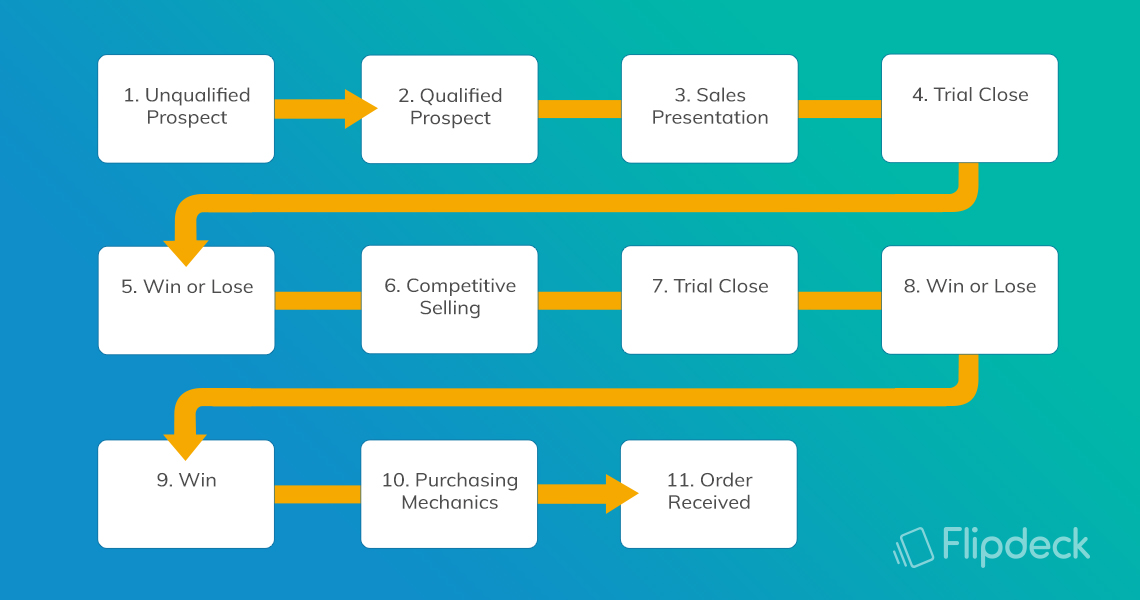"Plus Up" Your Classic Sales Process

Step 1: Unqualified Prospect
Some leads are better than others. Pay attention to the source of the lead in prioritizing your follow up.

Step 2: Qualified Prospect
Preparation:
-
Organize your products/services as a set of three choices. For example:
- Entry, Intermediate, Advanced
- Level 1, Level 2, Level 3
- A Group, B Group, C Group
-
Set boundaries for each choice. For example:
- Entry is for a customer just getting started, looking for a solution.
- Intermediate is a user looking to improve or expand capabilities.
- Advanced is a cutting edge (full bells and whistles) user.
Qualification: The goal is to help the customer "self-qualify" themselves.
- Briefly explain the three groups with usage examples and ballpark pricing. Describe how a typical customer uses the product/service.
- Ask the prospect, "Which category would you like me to cover?"

Step 3: Sales Presentation
- Present your value proposition for the category the prospect selected, pointing out any available options.
- Wrap up with a summary of how your product/service satisfies the category the prospect chose.
Step 4: Trial Close
- Say something like, "Have you found what you are looking for?"
- If they say "Yes," stop talking and go to Steps 9 and 10.
- If they hesitate, you can say something like, "Your hesitation makes me think there might be something I haven’t covered. Help me understand. What is it?"
- Listen and deal with the objection or question.
- Say something like, "Did that answer your questions or concerns?"
- You hope you will hear "Yes" so you can repeat the close. If you don’t get it, welcome to Step 5.
Step 5: Competition Enters
It would be very helpful to know who the other players are, but you are not likely to get that information directly — so look for clues as you move into Step 6.
Step 6: Competitive Selling
- Ask, "Has something changed?"
- Listen for competitive arguments that may have been planted.
- Play back what they say and deal with the arguments. If you've heard them before, you can have effective rebuttals prepared so you can give them to customers on the spot.
- If the issue they raise is a valid competitive weakness, ask them if the issue is a critical requirement or a preference. It would be great to have some customer referrals, case histories, etc. to share on the spot.
- Share alternate products/services that might meet their needs/wants. Try to get back to the evaluation process if you can.
Pro-tip — Use Flipdeck to instantly share content like effective rebuttals to objections, customer referrals, and alternate products or services.

Step 7: Trial Close
Ask the customer, "Is there anything I have said that might change your 'No' to a 'Maybe?'"
- Probe for what it would take.
- Summarize, "What I'm hearing is if I can solve ________, "maybe" could be back on the table?" If they say "Yes," ask for some time to find the solution. If they say "No," you are at Step 8.

Step 8: Win or Lose
- If you lost, be gracious. There could be other opportunities with this customer in the future.
- If you won congratulations! You have the beginnings of a great new customer relationship. Proceed to step 9.
Step 9: Win
Thank the customer for their trust in you and your company, and proceed to Step 10. Do not talk about the product/service anymore!

Step 10: Purchasing Mechanics
- Keep things moving forward. Make sure the customer has everything they need on the spot (current pricing, specs, how to order information etc.) for their internal process. (Be grateful if you have Flipdeck.)
- Don't get complacent. Your competition may try a last-minute Hail Mary play.
- Continue to follow up until the purchase order is received.
- Complete the process with a thank you follow-up message — such as "Thank You" cards you have stored in your Flipdeck account.
Step 11: Order Received
Bring the sale home and deliver on what you promised.
"Plus up" the classic sales process with Flipdeck
Flipdeck is built for sales content. Our simple cards & decks approach helps ensure that your sales team can quickly find and deliver the right content to your buyers at the right time.
- Your customers get the information they need in real time, lessening the chance of sales stalling out.
- You'll know which marketing content is working and which is not.
- Your sellers have the content they need in hand to move buyers to the close.
Give Flipdeck a try with our low-risk pilot, and let the results speak for themselves.
Create an
account and try Flipdeck FREE, no credit card required.
Looking for more details? See examples or visit our support resources page.
Learn more about Flipdeck Accounts & Pricing Options.
Have questions? We're happy to help! Check out our Frequently Asked Questions or email us
at \u0069\u006e\u0066\u006f\u0040\u0066\u006c\u0069\u0070\u0064\u0065\u0063\u006b\u002e\u0063\u006f\u006d.